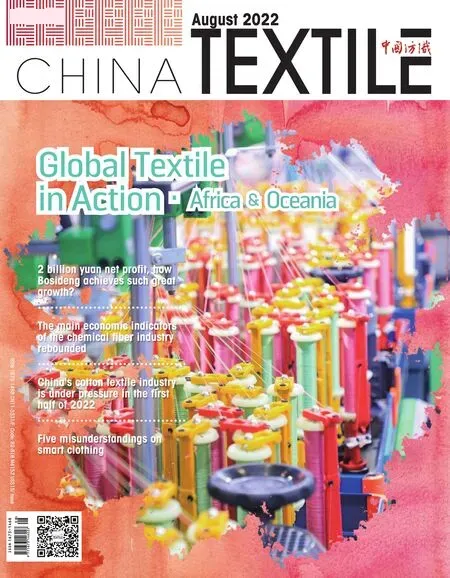Nigeria’s textile sector in urgent need of development
By Zhao Xinhua

Textile industry has been an age—long cot—tage industry in Nigeria, considering that Aso—Oke, Akwete as well as the dyeing pits of Kano constitute part of Nigeria’s cultural heritage.During the golden years of 1980—1990, Ni—geria was known throughout West Africa for its booming textile industry, which grew by 67 percent a year and covered the entire process of textile production. In its flourishing days, the industry had state—of—the—art textile machin—ery which surpasses any other sub—Saharan country, and the total textile machinery in the country far surpasses that of all remaining sub—Saharan countries put together.
Today, the sector supports fewer than 20,000 jobs due to Nigeria’s lagging infrastructure, particu—larly inadequate power supply, high financing costs and outdated production technologies. Attempts to resurrect the sector through fiscal policy and mon—etary intervention have failed miserably. This suggests that the textile industry in Nigeria still faces a harsh operating environment.
Nigeria made efforts to take advantage of African Growth and Opportunity Act (AGOA) but this could not materialize because of the cost of production.Although exports of textiles to the U.S. market are at zero tariff, it cannot compete with Asian countries that export textiles to the U.S. at 10 percent tariff.
With Nigeria’s urbanization and younger popula—tion, the demand for textiles and clothing is increasing.According to the Nigeria Textile Importers Association,more than 95 percent of the textiles on the Nigerian market now come from China, with only a small frac—tion coming from Turkey and India. Although some products are restricted or forbidden to be imported by Nigeria, the domestic production cost is high, which cannot meet the market demand. Therefore, textile importers order from China and then transfer to Be—nin to enter the Nigerian market. The former National Chairman of the Nigerian Textile Manufacturers Asso—ciation (NTMA), Ibrahim Igomu, said the ban placed on imported textile and finished clothing does not mean that the country would automatically stop buying textiles or clothing from other countries. He explained that the policy would only discourage importers from sourcing textile materials from overseas, but to look inwards and source their raw materials locally.
In 2021, Nigeria imported goods worth USD 22.64 billion from China, accounting for about 16 percent of Africa’s total imports from China. Among them, textile imports reached USD 3.59 billion, up 36.1 percent. Nigeria is also one of China’s top five export markets for eight categories of dyeing and printing products, with an export volume of more than 1 billion meters and a year—on—year growth rate of more than 20 percent. Nigeria continues to be China’s largest exporter to Africa and the sec—ond largest trading partner (the first largest trading partner is South Africa).
In recent years, the Nigerian government has supported the development of the country’s textile industry through various means, such as supporting cotton farming and promoting the application of cot—ton in the textile industry. The Central Bank of Nigeria(CBN) says it has invested more than 120 billion naira in the cotton, textiles and clothing (CTG) value chain since its intervention program in the sector. This is expected to increase the capacity utilisation of cotton ginning plants to meet and exceed the cotton wool requirements of the country’s textile industry, thus halting cotton imports. Cotton, the raw material used to make African printed fabrics, accounts for 40 per—cent of the total production cost, further reducing the cost of fabric production.
Some involved themselves in high—technology projects for the manufacture of polyester stable fiber(PSF), partially oriented yarn (POY) and polyester fila—ment yarn (PFY) all of which have direct linkage with the Petrol—chemical industry. There was the prom—ise, from the Government, that the country’s petrol chemical industry would provide necessary raw ma—terials for these factories. The non—functioning of the petrol—chemical industry in Nigeria has left the huge investment to waste away.
According to research findings by Euromonitor published in 2019, the African fashion market is worth USD 31b, with Nigeria accounting for about USD 4.7b (15 percent) of it. The figure is not only lower than South Africa’s current share of (USD 14.4b), though Nigeria has nearly four times its population, it can be improved upon with the na—tion’s rising population and resourceful youth. Al—though the textile sector is no longer a significant contributor to Nigeria’s foreign exchange profits and job creation there are still some textile en—terprises in Nigeria that produce high quality and fashionable textiles.
The situation in Nigeria’s textile industry may not improve soon, as nearly all mills face numerous challenges, including inadequate funding and electricity supply. This means that the revival of the textile sector will necessitate the government’s strong political will, commit—ment, and sincerity of purpose. and simply in—jecting billions of naira into the Textile Revival Fund will not be enough to revive the country’s collapsing textile industry. Industry insiders have called on the government to draw up a sustain—able development plan to steer the textile indus—try in the right direction.

